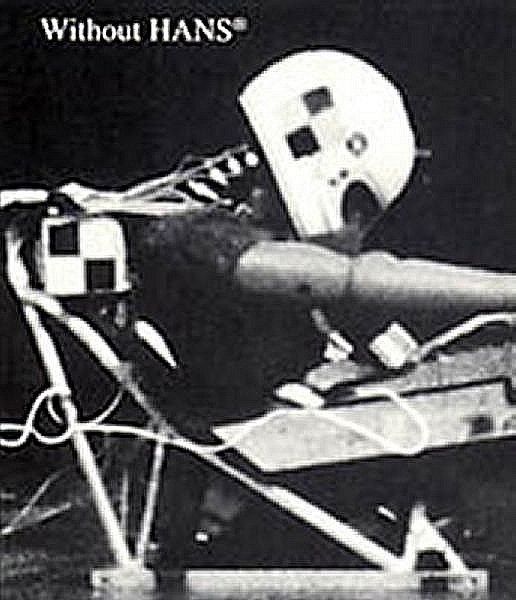The HANS (Head And Neck Support) device is nowadays regarded as a “sine qua non” piece of safety equipment in all major motor racing series worldwide. Everyone from Formula One to Indy Car, NASCAR, A1 GP, World Rally Championship – and the enumeration could go on – uses it as a mean of protection for drivers' head and neck (as obvious by the device's designation).
However, the device was only picked up by the aforementioned organizations mid-way through the 1990s, more than a decade after it was first developed by Dr. Robert Hubbard, a professor of biomechanical engineering at Michigan State University. After one of his friend died in an IMSA testing accident due to head injuries in the early 1980s, Hubbard (along with brother-in-law, road-racer Jim Downing) decided to develop some kind of a device able to protect the driver's head and neck at sudden stops (mainly accidents).
While initially not being taken into consideration by the majority of the racing series in North America – not to mention about the European based competitions – the device was immediately given more attention following several deaths within racers worldwide due to basilar skull fracture (occurring at the base of the skull).
Among famous drivers who lost their lives during the '90s (and afterwards) due to basilar skull fracture are F1's Roland Ratzenberger, NASCAR's Dale Earnhardt and John Nemechek, Indy 500's Tony Bettenhausen or CART's Gonzalo Rodriguez (the list could go on, of course)
Until finally being accepted in competitions like NASCAR or Formula 1, the HANS devise was heavily tested. While using the device, most drivers complained about its lack of comfort (due to the fact that it was quite heavy). Consequently, the U-shaped HANS device used nowadays is made of carbon-fiber (light composite, weighting around 630 grams), measures around 315 x 279 x 165 mm and works kinda' like this:
How you place it
The HANS device is placed with its curved section surrounding the driver's neck, while the two arms are laying along the top of the chest, over the shoulders and towards the pectoral muscles.
Now that we got the basics, one should be aware that the HANS device is never placed above the harness, but under it. This is very important, as the configuration of the aforementioned device actually maximizes the use of vertical safety belts, bringing them closer together for improved protection.
Also, as shown in the standard HANS manual, the device should never touch either the helmet, or the headrest. A minimum clearance of 1.5 inches (approximately 40 mm) is required between the device and the aforementioned parts. From that point on, one only has to properly adjust the tethers (making the connection between the device and the helmet) for better fitting and the job is done.
Robert Kubica violently hits the concrete barrier during the 2007 Canadian Grand Prix
GP2 driver Ernesto Viso during the 2007 race at Magny Cours
John Force crashes into Kenny Bernstein and then into the concrete barrier during a race in Dallas (2007)
Now that we got the basics, one should be aware that the HANS device is never placed above the harness, but under it. This is very important, as the configuration of the aforementioned device actually maximizes the use of vertical safety belts, bringing them closer together for improved protection.
Also, as shown in the standard HANS manual, the device should never touch either the helmet, or the headrest. A minimum clearance of 1.5 inches (approximately 40 mm) is required between the device and the aforementioned parts. From that point on, one only has to properly adjust the tethers (making the connection between the device and the helmet) for better fitting and the job is done.
How it works
We'll now try to describe, in as few words as possible, how the driver's head behaves itself during an accident. When the car hits something, it produces a sudden stop, causing the body of the driver to go forward. As seat belts are mandatory in motor racing since forever, the body – central part and shoulders – will be prevented from going forward, but not the head. Consequently, the rear of the skull suffers intensive damage at impact, causing tears in the membranes surrounding the brain, broken bones in the skull and injury of cranial nerves.What the HANS device did, at first, was to dramatically reduce the loads during an accident – “below the injury tolerance thresholds,” as argued by Hubbard himself, after conducting several tests on it – transferring it from the back of the skull to its forehead (which is better prepared for taking on such an impact). Tests have revealed that drivers were able to resist forces of about 35 Gs and 40 mph velocity change.
In the mid-90s, Mercedes Benz have decided to further develop the device in order to implement it in their Formula One programme. After further evaluation from the International Automobile Federation, the device was eventually introduced as a mandatory feature in 2003 (two years later than in the North American CART Series). The National Hot Rod Association followed in setting it mandatory in 2004, before NASCAR in 2005 (the same year as the WRC). As shown before, these decisions were taken after some unfortunate deaths within the drivers competing in the aforementioned series occurred.Under its current form, the semi-hard carbon-fiber collar can reduce head movement in a crash by up to 44%, the force applied to the neck by up to 86% and the acceleration applied to the head by up to 68%.
Here are some accidents after which the drivers escaped unharmed due to the use of HANS.Robert Kubica violently hits the concrete barrier during the 2007 Canadian Grand Prix
GP2 driver Ernesto Viso during the 2007 race at Magny Cours
John Force crashes into Kenny Bernstein and then into the concrete barrier during a race in Dallas (2007)

